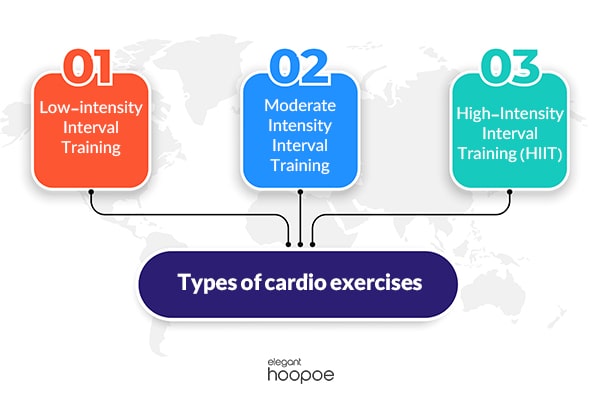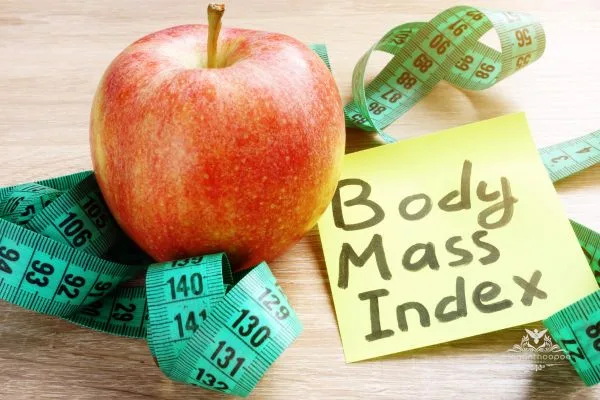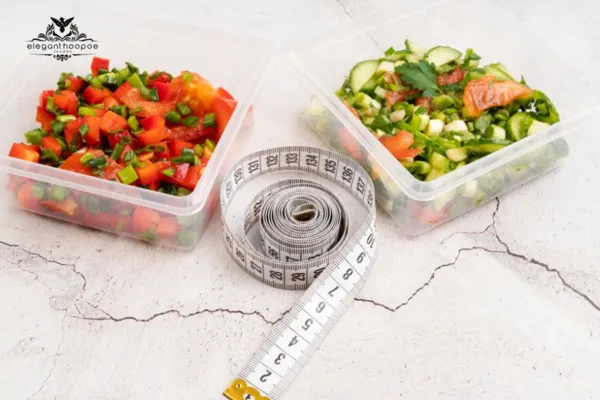What Is the Best Cardio for Weight Loss? Find Out Which Workouts Burn Fat Fast!
Looking for the best cardio for weight loss? The most effective workouts depend on your goals:
- For fast fat loss: HIIT, running sprints, and jump rope burn the most calories quickly.
- For belly fat: Kickboxing, stair climbing, and HIIT are great options.
- For endurance & low-impact exercise: Swimming and cycling are effective without stressing your joints.
- At-home options: Jump rope, burpees, and dancing provide convenient fat-burning workouts.
Pairing cardio with a proper diet maximizes weight loss results. Want quicker fat reduction? Try incline running, sprint intervals, or HIIT sessions for the ultimate calorie burn!
Cardio exercise have long been recognized for their effects on weight loss. Workouts like running, swimming, hiking, etc. are the best cardio workouts for weight loss, and also a great way to be healthier and fitter because they make your heart beat faster and help you breathe more and better. For cardio workouts, you might have different goals, target body areas, or questions like, “What is best cardio exercises?“What is the best cardio for weight loss?

So, we are here to check the details about cardio to determine its effectiveness for weight loss and how much time you need to see significant results.
The American College of Sports Medicine (ACSM) recommends that adults get at least 30 minutes of moderate-intensity aerobic activity or cardio exercise five days a week or 20 minutes of vigorous activity three days a week.
What are the Cardio types?
Generally, all activities that increase your heartbeat and breathing are called cardio exercises. As all we know, cardio exercises are various, and each one targets a different area and helps you achieve specific goals. Look at the table below; we break down all the types of cardio workouts into two different categories that help you know the details about every workout based on your goals and even the level of activity:

Moderate to High-Impact Cardio Exercises:
| Cardio Type | Description | Key Benefits | Best For | Considerations/Drawbacks |
| Running/Jogging | Running or jogging at a steady pace on a treadmill or outdoors. | Burns high calories Improves cardiovascular endurance | Weight loss Improving heart health | High impact on joints Requires good shoes to prevent injuries |
| Jump Rope | Using a rope to jump continuously. | Very effective for burning calories Improves coordination and balance | Quick, intense workout Busy individuals | Requires coordination and practice It can be tough on knees and ankles |
| HIIT (High Intensity Interval Training) | Alternating between High-intensity exercise and rest periods. | Burns calories in a short time Improves metabolism | Fat loss, time-efficient Advanced trainees | Requires a good fitness base It can lead to burnout if overdone |
| Kickboxing | Combines boxing with kicking, which can be done with a bag or in classes. | Improves agility, strength, and coordination Great for stress relief | Those who enjoy martial arts-based fitness Cardiovascular and strength improvements | Requires instruction for proper technique Risk of injury if done without proper form |
| Stair Climbing | Climbing real stairs or using a stair climber machine. | Strengthens lower body and core muscles Great for endurance | Individuals looking for functional fitness Building leg and glute strength | High impact on knees and lower body joints Can be monotonous |
| Rowing | Full-body exercise performed on a rowing machine or boat. | Engages all major muscle groups Good for improving posture | Full-body muscle building and cardio Building endurance | It can strain the lower back if the form is incorrect. Requires equipment or access to water |
Related article: Exercises for belly fat
Low to moderate-impact Cardio Exercises:
| Cardio Type | Description | Key Benefits | Best For | Considerations/Drawbacks |
| Cycling | Stationary or outdoor biking can vary in intensity. | Low-impact, easy on joints Builds leg strength | Beginners to advanced Improving lower body muscle tone | Risk of accidents if done outdoors It can cause discomfort in the lower back or neck |
| Swimming | A full-body workout performed in a pool includes different strokes. | Full-body engagement improves flexibility. Low impact, suitable for recovery | People with joint issues Overall fitness improvement | Requires pool access It can be challenging for beginners. |
| Elliptical Trainer | Low-impact machine simulating Walking or running without joint stress. | Joint-friendly, low impact Good for low-intensity, long-duration sessions | People recovering from injury Weight maintenance | It can become monotonous if done frequently. Limited variety in movement |
| Dancing | Engaging in various dance styles like Zumba, salsa, or hip hop. | Fun and engaging, good for stress relief Full-body workout | Social individuals Improving flexibility | It may require learning dance routines. They may not burn calories as quickly as others |
| Walking | Walking at a steady or brisk pace, outdoors or on a treadmill. | Easy and accessible for all fitness levels Boosts mood and cardiovascular health | Beginners, older adults, pregnant women Maintaining a healthy lifestyle | Slow calorie burn requires longer durations. Limited intensity may not challenge athletes. |
Do you know What is the Fastest Way to Reduce Breast Size?
The information above says everything you need to know about cardio exercise. In the following, we will dive into a table with some specific questions in your mind.
Best Cardio Exercise for Different Goals

Fat loss is not the only goal when deciding to do cardiovascular exercise. You must also want to live a healthier life for a long time, have a more shaped, fit body, improve mental health, or want all of these together by engaging in the best cardio workouts for weight loss.
Below, we mentioned the three most well-known targets among people about cardio exercise:
1. Fat Loss and Muscle Gain (muscle toning)
Cardio exercises are a good idea if you want to lose fat and build muscles. These exercises work multiple muscles at once and can help you get in better shape.
- Therefore, rowing is ideal as it provides upper and lower body exercises and cardiovascular exercises.
- Swimming is also a full-body cardio exercise that includes resistance to help build muscles and shed calories.
- Lastly, cycling with some sort of resistance can shape the legs and build muscle endurance and strength, not to mention the fat burned during this process.
For these exercises to be designed for muscle building, use some form of resistance or strength, i.e., higher tension on the machines or intervals.

2. Best Cardio to Burn Belly Fat
Not all cardio exercises are created equal when losing abdominal fat. But here are some options that may help you with that:
- HIIT workouts, especially if you combine sprints and jumping jacks, will be most effective in burning the fat around your tummy because they require high energy expenditure both during and after exercise.
- Another great option is kickboxing. The core muscles are worked right from movement, with twists directed to the abdominal muscles.
- Another recommendable strategy for reducing belly fat is stair climbing. It offers lower body exercise and engages the abdominal muscles. They are proven to be the best cardio workouts for weight loss, but they would be most effective alongside core-specific strength exercises such as planks and leg raises.
3. For Cardiovascular Endurance:
When it comes to cardiovascular endurance, the major focus is on the heart and lungs’ ability to deliver oxygen to muscles during prolonged activities.
Swimming and cycling are good suggestions for this because they consist of continuous and steady motions that maintain a good heart rate without putting additional stress on joints. After setting your target, you have two options for your workout: cardio exercise at home and training in a gym.
When comparing workouts at a gym and workouts at home, it’s important to note that they can both be effective for weight loss. While gyms have special machines designed for effective fat loss, you can still get a good workout at home without any equipment.

Best Cardio for Weight Loss at Home
if you wish to drop those extra pounds Without getting the time to go gyms, you can do the options below:
- Standard jump rope is one of the most effective exercises because it expends a lot of calories for a relatively short duration and can be practiced from virtually any location.
- Some exercises help burn calories during full-body exercises like burpees, mountain climbers, jumping jacks, and more. These workouts raise your pulse and incorporate your body weight in the courses of resistance, which can help you lose weight.
- Dancing is yet another great way to burn calories. If you prefer a more fun approach, dancing moves like Zumba or an aerobic routine can be an engaging and enjoyable way to burn calories. These exercises are great for both men and women without expensive gym equipment (performers without central exercise machinery).
Suggested content: Is does yoga help you lose weight What the research say?
Best Cardio Machine for Weight Loss
Since weight loss machines are available, some are more effective than others. Most are used in Gyms, but some, like treadmills, can be used in a typical house. The machines include:
- A treadmill is the most effective machine for losing calories, whether you love running Uphill or not. It increases the impact without having to move at a quicker pace, thus making it a must-have for both novices and experts.
- The rowing machine is also a stellar choice – it works vigorously in all the major muscle groups, supplies many calories burned, and is utterly safe for the cardiovascular system.
- An elliptical trainer is suitable for those who want a non-weight-bearing exercise that produces a high energy expenditure—just alter the resistance settings for optimal results.
- The stair climber is also good as it mainly works the large muscles on the leg. This helps to raise the level of intensity and, therefore, burn more fat.
Read more about Can you lose weight with a treadmill?
Cardio vs. Diet for Weight Loss

If you don’t follow the proper diet and cut back on calories, cardio workouts may not give you the results you want. Whole foods, lean proteins, and healthy fats provide the macronutrients needed to assist your body in its ability to strip fat while providing the energy required by cardio sessions.
To get the best results with your fitness and health, it’s important to combine cardio exercise with a healthy diet. Cardio helps you burn off extra calories from your body; at the same time, a correct dieting plan ensures that the calories are not being replaced, hence the much-needed deficit to eliminate fats.
The solutions:
ElegantHoopoe diet expert in Dubai aims to provide individual weight loss solutions based on the treatments, physical activities, and diet that will suit the intended goals without straining your health.You can read also about INFRASLIMX in Dubai ,Advanced Body Shaping Machine.

Best Cardio to Lose Weight Fast
Are you searching for the best cardio workouts for weight loss to help you lose pounds in less time? Sometimes, you are on a hurray for weight loss, like when your wedding time is near, or you want to go on a trip and wear your perfect bikini.
If you want to get thin as soon as possible, high-intensity cardio exercises are your most effective option. HIIT exercises entail a set state of activity and are followed by a short recovery period.
This method helps you lose considerable calories quickly and, most beneficially, burns fat after the workout through the afterburn effect.
- It also helps to run at an incline or make sprints to burn the maximum calories in the shortest time possible.
- For those with less time, rope skipping would be an excellent exercise since it is fast and effective in burning calories quickly due to its intensive nature.
You might also like: How to lose weight at home? Easy methods and fastest ways to lose fat in home.
Following the above information, the next question arises:
Which Cardio Burns the Most Fat?
We summarize the actual answer in the table below:
| Cardio Type | Why It Burns the Most Fat | Best Practices for Maximum Fat Burn |
| HIIT | High-intensity intervals cause a significant increase in calorie burn even after a workout (afterburn effect). | Keep sessions short but intense (20–30 minutes). |
| Running (Sprints) | Sprints elevate heart rate quickly and keep it high, burning more fat. | Add intervals to maximize calorie burn. |
For those aiming to see quicker results, clinical weight loss options offer a targeted approach to burning fat more efficiently. Noninvasive fat-loss methods like CoolSculpting, Emsculpt, and laser lipo can help you lose fat faster by breaking down fat cells. This will allow the body to eliminate such cells more effectively in real-time. Since fat is frozen or muscles are being toned, such procedures are more effective than surgery since the time of healing is not considered.
Sometimes working out and getting a regime only not worked for individual people; For those one who want to combine their workouts with more targeted fat-reduction plans, the clinical options listed above may be the best choice.
If you do these treatments along with personalized exercise and cardio, you will burn more fat and see results faster.






